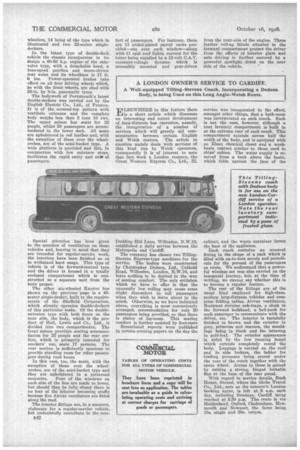• A LONDON OWNER'S SERVICE TO CARDIFF.
Page 26

If you've noticed an error in this article please click here to report it so we can fix it.
A Well-equipped Tilling-Stevens Coach, Incorporating a Dodson Body, is being Used on this Long Anglo-Welsh Route.
LSEWHERE in this feature there F45 a short article which discusses an interesting and recent development of long-distance bus operation, namely, the inauguration of a number of services which will greatly aid communication between certain English and Welsh centres. The article in question mainly deals with services of this kind run by Welsh operators, consequently it is of interest to note that last week a London concern, the Great Western Express Co., Ltd., 32, Budding Hill Lane, Willesden, N.W.10, established a daily service between the Metropolis and Cardiff.
The company has chosen two TillingStevens Express-type machines for the service. The bodies were constructed by Christopher Dodson, Ltd. Cobbold Road, Willesden, London, N.W.10, and leave nothing to be desired in the way of seating comfort. The only criticism which we have to offer is that the unusually low ceiling may cause some slight discomfort to tall passengers when they wish to move about in the coach. Otherwise, as we have indicated above, everything is most conveniently arranged, accommodation for only 20 passengers being provided, so that there is plenty of leg-room. This seating comfort is further assisted by foot-rests Sensational reports were published in certain evening papers on the day the
service was inaugurated to the effect, amongst other things, that a bath-room was incorporated on each coach. Such is not the case, however, although a neat lavatory compartment is built in at the extreme rear of each coach. This compartment extends across half the width of the body, and is equipped with an Elsan chemical closet and a washbasin cabinet similar to those used in ships' cabins. The water supply is received from a tank above the basin, which folds against the face of the
cabinet, and the waste container forms the base of the appliance.
Each coach contains an unusual fitting in the shape of a rack which is filled with up-to-date novels and periodicals for the perusal of the passengers en route. We understand that a powerf (al wireless set was also carried on the inaugural journey, but, at the time of writing, we cannot say whether this is to become a regular feature.
The rest of the fittings are of the usual kind employed for high-class, modern long-distance vehicles and comprise folding tables. Airs-se ventilators, Beclawat circular, ash-trays, a clock in the forward bulkhead, a bell-push for each passenger to communicate with the driver, etc. The interior is tastefully finished in brown and the exterior in grey, primrose and maroon, the mouldings being in black and the lettering in gold-leaf. The exterior appearance is aided by the low running board which extends completely round the body. Luggage is carried on the roof and in side lockers., the ladder for loading purposes being stored under the rear of the coach together with the spare wheel. Access to these is gained by raising a strong, hinged lockable flap at the base of the rear panel.
With regard to service details, Bush House, Strand, where the Globe Travel Co., Ltd., acts as the concern's London booking agent, is left at 9 a.m. each day, including Sundays, Cardiff being reached at 5.30 p.m. The route is via Maidenhead, Oxford, Cheltenham, Monmouth and Newport, the fares being 15s. single and 28s. return.
































